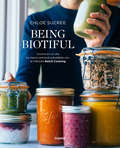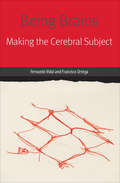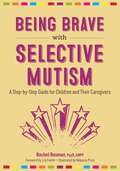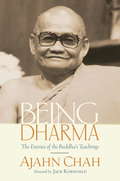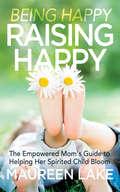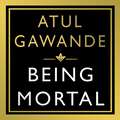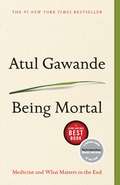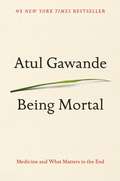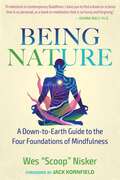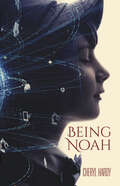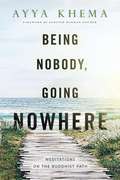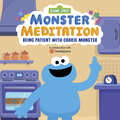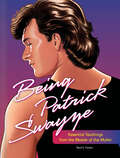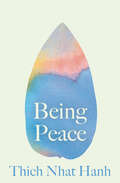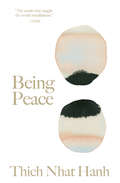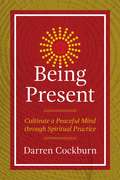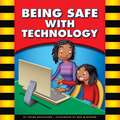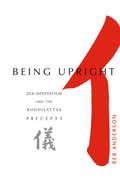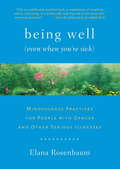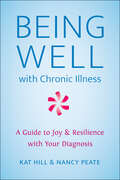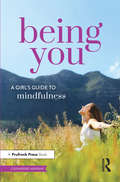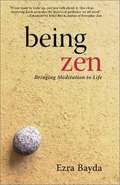- Table View
- List View
Being Biotiful: Comidas deliciosas, rápidas y saludables con el método Batch Cooking
by Chloé SucréeCuídate preparando comidas deliciosas, rápidas y muy saludables con el método Batch Cooking. ¡Organízate y disfruta! Comer saludable no siempre es fácil y más si volvemos tarde a casa, cansados y con mucha hambre y, al final, ya sea por falta de tiempo o de inspiración, es fácil caer en la trampa de comer algo precocinado, sin ningún tipo de elaboración y, por lo general, poco sano. Pero ¿y si te digo que se puede comer saludable aun teniendo poco tiempo? Chloé, fundadora del blog Being Biotiful que cuenta con miles de seguidores, nos enseña el método Batch Cooking, una manera de planificar y preparar comidas saludables, caseras y fáciles para toda la semana en tan solo una tarde. Tras años de práctica en el arte de tostar y mezclar semillas, batir frutas y verduras y combinar ingredientes de manera sorprendente, nos cuenta su historia y sus consejos esenciales e inspiradores para cambiar nuestra rutina alimentaria y encaminarnos hacia una dieta vegetariana, orgánica y de temporada.
Being Brains: Making the Cerebral Subject (Forms Of Living Ser.)
by Fernando Vidal Francisco OrtegaThis &“interesting, informative, and provocative book&” explores the pervasive influence of neuroscience and &“the view that we are essentially our brains&” (History and Philosophy of the Life Sciences). Being Brains offers a critical exploration of neurocentrism, the belief that &“we are our brains,&” which came to prominence in the 1990s. Encouraged by advances in neuroimaging, the humanities and social sciences have gravitated toward the brain as well, developing neuro-subspecialties in fields such as anthropology, aesthetics, education, history, law, sociology, and theology. Even in the business world, dubious enterprises such as &“neuromarketing&” and &“neurobics&” have emerged to take advantage of the heightened sensitivity to all things neuro. While neither hegemonic nor monolithic, the neurocentric view embodies a powerful ideology that is at the heart of some of today&’s most important philosophical, ethical, scientific, and political debates. Being Brains examines the internal logic of this new ideology, as well as its genealogy and its main contemporary incarnations. Being Brains was chosen as the 2018 Outstanding Book in the History of the Neurosciences by the International Society for the History of the Neurosciences.
Being Brave with Selective Mutism: A Step-by-Step Guide for Children and Their Caregivers
by Rachel BusmanIf you've picked up this book, talking is probably pretty hard for you. Maybe you really want to talk but feel too nervous to do it when lots of eyes are on you. Perhaps you can talk to certain people but not others or you can only speak a few words in a soft voice. No matter what you are going through, the tips and activities in this book can help you to feel braver about talking.Selective mutism can be tricky to manage. This workbook helps you and your child formulate a plan for exposure activities, and breaks down talking into attainable steps. It includes examples of games to play while practicing talking and offers sample dialogues to illustrate how to do exposures. Pairing a system of rewards along with the exposures helps your child through the challenge of dealing with those uncomfortable feelings. It discusses different situations and places where talking can be difficult and introduces two children, Emily and Jackson, who are both working hard to tackle their selective mutism.Packed full of activities, worksheets and helpful strategies, this book makes putting in the work of being brave around talking fun!
Being Dharma: The Essence of the Buddha's Teachings
by Jack Kornfield Ajahn ChahChah offers a thorough exploration of Theravadan Buddhism in a gentle, sometimes humorous, style that makes the reader feel as though he or she is being entertained by a story. He emphasizes the path to freedom from emotional and psychological suffering and provides insight into the fact that taking ourselves seriously causes unnecessary hardship.Ajahn Chah influenced a generation of Western teachers: Jack Kornfield, Sharon Salzberg, Sylvia Boorstein, Joseph Goldstein, and many other Western Buddhist teachers were at one time his students. Anyone who has attended a retreat led by one of these teachers, or read one of their books, will be familiar with this master's name and reputation as one of the great Buddhist teachers of this century.
Being Fit: Healthy Plates (Into Reading, Read Aloud #Module 4 Book 1)
by Valerie BoddenNIMAC-sourced textbook
Being Happy, Raising Happy: The Empowered Mom's Guide to Helping Her Spirited Child Bloom
by Maureen LakeAn educator, holistic health coach and mother shares tips for self-care and mental wellness for mothers of strong-willed and highly-sensitive children. You Were Born Happy. You Were Born to Be Happy. You Were Born to Raise Happy. Being a mom is a lot of work. Being a mom of a spirited child can be exceptionally challenging. Moms who want to change their stress and anxiety levels and make a difference in the lives of their children and family need to take steps towards wellness. Maureen Lake teaches moms: · The reason why parenting a spirited child can cause more stress and anxiety than parenting kids who don&’t have the same challenges · The importance of cherishing yourself and setting clear boundaries so you can nurture your child · How to uncover the areas of your life that are causing the most stress and worry · How to regain footing by following a five-step process toward peace of mind · How to better manage family life with a nutrition plan to increase energy and other wellness tips that boost the immune system and create better overall health Being Happy, Raising Happy is for loving and caring moms who somehow forgot about their own desires and the impact they want to make in the world. This accessible guide will help women begin the journey towards revitalizing the mind, body, and spirit. &“Upon reading the first few pages, I was totally hooked. I felt like Maureen was sitting across the table teaching me the importance of taking care of myself and how my wellness will positively impact my child.&” —Gretchen Burman, author of The Adventures of Ooga and Zeeta
Being Healthy
by Larry K. Olsen Richard W. St. Pierre Jan M. OziasThis book is a guide to staying healthy and fit with suggestions on food habits, exercises, disease, and life style.
Being Henry David
by Cal ArmisteadSeventeen-year-old "Hank" has found himself at Penn Station in New York City with no memory of anything --who he is, where he came from, why he's running away. His only possession is a worn copy of Walden, by Henry David Thoreau. And so he becomes Henry David-or "Hank" and takes first to the streets, and then to the only destination he can think of--Walden Pond in Concord, Massachusetts. Cal Armistead's remarkable debut novel is about a teen in search of himself. Hank begins to piece together recollections from his past. The only way Hank can discover his present is to face up to the realities of his grievous memories. He must come to terms with the tragedy of his past, to stop running, and to find his way home.
Being Mortal: Illness, Medicine and What Matters in the End
by Atul GawandeFor most of human history, death was a common, ever-present possibility. It didn't matter whether you were five or fifty - every day was a roll of the dice. But now, as medical advances push the boundaries of survival further each year, we have become increasingly detached from the reality of being mortal. So here is a book about the modern experience of mortality - about what it's like to get old and die, how medicine has changed this and how it hasn't, where our ideas about death have gone wrong. With his trademark mix of perceptiveness and sensitivity, Atul Gawande outlines a story that crosses the globe, as he examines his experiences as a surgeon and those of his patients and family, and learns to accept the limits of what he can do.Never before has aging been such an important topic. The systems that we have put in place to manage our mortality are manifestly failing; but, as Gawande reveals, it doesn't have to be this way. The ultimate goal, after all, is not a good death, but a good life - all the way to the very end.Published in partnership with the Wellcome Collection.WELLCOME COLLECTIONWellcome Collection is a free museum and library that aims to challenge how we think and feel about health. Inspired by the medical objects and curiosities collected by Henry Wellcome, it connects science, medicine, life and art. Wellcome Collection exhibitions, events and books explore a diverse range of subjects, including consciousness, forensic medicine, emotions, sexology, identity and death.Wellcome Collection is part of Wellcome, a global charitable foundation that exists to improve health for everyone by helping great ideas to thrive, funding over 14,000 researchers and projects in more than 70 countries.wellcomecollection.org
Being Mortal: Medicine and What Matters in the End
by Atul GawandeIn Being Mortal, bestselling author Atul Gawande tackles the hardest challenge of his profession: how medicine can not only improve life but also the process of its ending<P> Medicine has triumphed in modern times, transforming birth, injury, and infectious disease from harrowing to manageable. But in the inevitable condition of aging and death, the goals of medicine seem too frequently to run counter to the interest of the human spirit. Nursing homes, preoccupied with safety, pin patients into railed beds and wheelchairs. Hospitals isolate the dying, checking for vital signs long after the goals of cure have become moot. Doctors, committed to extending life, continue to carry out devastating procedures that in the end extend suffering.<P> Gawande, a practicing surgeon, addresses his profession’s ultimate limitation, arguing that quality of life is the desired goal for patients and families. Gawande offers examples of freer, more socially fulfilling models for assisting the infirm and dependent elderly, and he explores the varieties of hospice care to demonstrate that a person's last weeks or months may be rich and dignified.<P> Full of eye-opening research and riveting storytelling, Being Mortal asserts that medicine can comfort and enhance our experience even to the end, providing not only a good life but also a good end.<P> <P><b>A New York Times Bestseller</b>
Being Mortal: Medicine and What Matters in the End
by Atul GawandeIn Being Mortal, bestselling author Atul Gawande tackles the hardest challenge of his profession: how medicine can not only improve life but also the process of its ending<P> Medicine has triumphed in modern times, transforming birth, injury, and infectious disease from harrowing to manageable. But in the inevitable condition of aging and death, the goals of medicine seem too frequently to run counter to the interest of the human spirit. Nursing homes, preoccupied with safety, pin patients into railed beds and wheelchairs. Hospitals isolate the dying, checking for vital signs long after the goals of cure have become moot. Doctors, committed to extending life, continue to carry out devastating procedures that in the end extend suffering.<P> Gawande, a practicing surgeon, addresses his profession’s ultimate limitation, arguing that quality of life is the desired goal for patients and families. Gawande offers examples of freer, more socially fulfilling models for assisting the infirm and dependent elderly, and he explores the varieties of hospice care to demonstrate that a person's last weeks or months may be rich and dignified.<P> Full of eye-opening research and riveting storytelling, Being Mortal asserts that medicine can comfort and enhance our experience even to the end, providing not only a good life but also a good end. <P><b>A New York Times Bestseller</b>
Being Nature: A Down-to-Earth Guide to the Four Foundations of Mindfulness
by Wes Nisker• Provides a practical program, complete with enjoyable, even playful meditations, for realizing greater self-awareness, increased wisdom, and happiness• Shows how recent discoveries in physics, evolutionary biology, and psychology express in scientific terms the same insights the Buddha discovered more than 2,500 years ago• Reveals the origins of attachments, desires, emotions, and thoughts in our own bodiesTaking us on an evolutionary journey to find the origins of emotions, desires, and thoughts in our own bodies, Wes &“Scoop&” Nisker shows not only how cutting-edge science is proving the tenets of the Buddha but also how we can interpret the traditional practices of Buddhism through this scientific lens for more personal freedom and peace of mind. Using the traditional Buddhist meditation series of the Four Foundations of Mindfulness as a framework, Nisker offers a witty narrative along with practical meditations and exercises to train the mind to overcome painful conditioning and gain greater self-awareness, increased wisdom, and happiness. He shows how recent discoveries in physics, evolutionary biology, and psychology express in scientific terms the same insights the Buddha discovered more than 2,500 years ago, such as the impermanence of the body, where thoughts come from, and how the body communicates within itself. Presenting a variety of new ways to harness the power of mindfulness to transform our understanding of both ourselves and the world, Nisker teaches us how to put our understanding of evolution in the service of spiritual awakening.
Being Noah
by Cheryl HardyTen-year-old Noah has a gift beyond the natural gifts of humans. This ability allows him to hear the thoughts of the family therapy dog, Ozzie, and to see visions of the future, which go unnoticed by the people who should love him and trust him the most.Noah&’s brother Sean is on the autism spectrum and receives more attention from their parents, at least more than Noah gets…which causes him to feel angst, sadness, frustration, and jealousy. Noah wants what all children want, love and acceptance. He needs his parents and grandmother to trust him and help him gain confidence in himself. Being Noah is a story of a boy believing in himself, even when others don&’t, and finding a way to use his gifts so he can affect change in the world and lives of those around him. Being Noah is Margaret Cheryl Hardy&’s first and only work, written in the MFA program at Western Colorado University. "A thoughtful book that is well-paced and includes enough realism to balance the mystical and spiritual content. A great book for introspection and discussion after reading."—School Library Journal
Being Nobody, Going Nowhere
by Ayya Khema Zoketsu Norman FischerIn this lucid classic, beloved teacher Ayya Khema introduces the reader to the essence of the Buddhist path. She addresses the how and why of meditation, providing a clear framework for understanding the nature of karma and rebirth and the entirety of the eightfold path. With specific, practical advice Ayya Khema illuminates the practices of compassion and sympathetic joy and offers forthright guidance in working with the hindrances that we all encounter in meditation. Few introductory books are both simple and profound. Being Nobody, Going Nowhere is both.
Being Patient with Cookie Monster: Sesame Street Monster Meditation in collaboration with Headspace (Monster Meditation)
by Random HouseCookie Monster learns simple meditation techniques and plays a fun game to help be more patient--based on the popular Sesame Street Monster Meditation video on YouTube made in collaboration with the mindfulness app Headspace.Sometimes everyone needs to slow down and take some cleansing belly breaths--even Cookie Monster! This terrific board book features Cookie Monster learning a calming game to help pass the time as he waits for his cookies to finish baking. The game is a fun and simple one that all young boys and girls can easily play whenever they need to be patient.This is Book 1 in a series of 6 books, all inspired by the popular Sesame Street Monster Meditation videos on YouTube, that will help young girls and boys learn mindfulness techniques along with their favorite characters. The videos are made in collaboration with Headspace, the mindfulness app. Sesame Workshop, the nonprofit educational organization behind Sesame Street, aims to help kids grow smarter, stronger, and kinder through its many unique domestic and international initiatives. These projects cover a wide array of topics for families around the world.
Being Patrick Swayze: Essential Teachings from the Master of the Mullet
by Neal E. FischerA humorous illustrated guide to the essential teachings of 80s and 90s pop culture icon and legacy, Patrick Swayze, with movie quotes, trivia, essays, exercises, games, activities, and quizzes.Divided into five elements—Tender Strength (versatility in performances and balance of his unique skill set), Pure Adrenaline (his physicality and death-defying stunt work), Hungry Eyes (effortless sensuality in life and on-screen), Peaceful Warrior (the philosophy behind his characters and their actions) and The Mullet (legacy of the man, the myth, the mullet)—this book is designed to cultivate your mind, body, and soul.Through the use of movie quotes and cinematic wisdom, physical (Sweatin' Like Swayze; Swayze Sutra) and mental exercises, games, activities (Swayze Pairing Guide), and quizzes, this journey will unlock your Swayze swagger, leading to a more harmonious life. When completed, you'll be impressing friends and strangers alike with your endless knowledge and admiration for one of Hollywood's most likable and underappreciated stars.For half a century Patrick Swayze has remained in our hearts, on our minds, and the sole reason that any trip to a vacation resort must first start at the dance hall . . . just in case they employ their own Johnny Castle. Embrace these teachings and achieve newfound clarity in all aspects of your life.BELOVED ICON: Patrick Swayze will forever be an icon, known for his legendary roles in classic and cult favorite movies like Dirty Dancing, Ghost, Point Break, Road House, and more.THE PERFECT GIFT: Chock full of trivia, behind-the-scenes anecdotes, short essays, and fun interactive content like quizzes, a pairing guide, a Swayze workout, and more, this is the perfect gift for Patrick Swayze fans and anyone who grew up in the 80s and 90s.FUNNY AND INFORMATIVE: Content is humorous, yet still contains biographical information, fun facts about Swayze and his philosophies, and tons of movie trivia.EXPERT AUTHOR: Written by an award-winning screenwriter and podcaster, and die-hard Patrick Swayze fan.Perfect for:• Patrick Swayze fans• Readers with '80s and '90s nostalgia• Hollywood pop culture nerds and film buffs• Fans of Dirty Dancing, Point Break, Road House, Ghost, and Red Dawn
Being Peace
by Thich Nhat HanhTHE BELOVED SPIRITUAL CLASSIC: A timeless introduction to Thich Nhat Hanh&’s most important teachings, revealing the connection between peace in oneself and peace in the world.Now updated with a foreword from Dr. Jane Goodall!One of Thich Nhat Hanh&’s first books published in the United States, Being Peace was intended for peace activists and as a commentary on the peace movement of the time. Now translated into more than 30 languages and with half a million copies sold, it has since become an indispensable guide for anyone concerned about the state of the world and the quality of our lives. Thay&’s message of &“being peace in order to make more peace&” is more relevant than ever. Being Peace contains Thich Nhat Hanh&’s key practices and is filled with practical suggestions for how to create a more peaceful world &“right in the moment we are alive.&” Many of the hallmarks of Thich Nhat Hanh appear here for the first time, in his trademark clear and steady style. Now featuring a foreword from Dr. Jane Goodall, this beautiful, newly revised edition is the perfect starting point for those who are getting their first introduction to Buddhism as well as a must-have for those already engaged in the tradition.
Being Peace: Classic Teachings From The World's Most Revered Meditation Master (Thich Nhat Hanh Classics)
by Thich Nhat HanhBeing Peace is a timeless and eloquent introduction t Zen Master Thich Nhat Hanh and his most important teachings. First published in 1987 and translated into more than thirty languages, this spiritual classic reveals the connection between our own personal happiness and the state of the world around us. Thich Nhat Hanh’s key practices are resented in simple and clear language, offering practical suggestions for how to create a more peaceful world "right in the moment we are alive." Being Peace is a must-have for those interested in Buddhist practice and a perfect starting point for anyone concerned about how to create peace in themselves and the world.
Being Present: Cultivate a Peaceful Mind through Spiritual Practice
by Darren CockburnFree yourself from unhelpful thoughts and emotions and learn to live peacefully in the present • Provides practical exercises, meditations, and reflections centered on mindfulness, breath, and immersion in nature to simplify your life and anchor you in the present • Learn to use your body as a tool for raising consciousness, work with occurrences like tiredness, illness, and pain as spiritual teachers, as well as identify and release addictions, including harmful thought patterns • Can be integrated with any religion or spiritual teaching with examples pertaining to everyday experiences in the Western world Offering a synthesis of spiritual teachings viewed through the lens of modern personal experiences, Darren Cockburn provides practical insight into how to cultivate a peaceful mind, live skillfully, and nurture a spiritual connection through the power of the present moment. The author shares practical exercises, meditations, and reflections, revealing how to free yourself from becoming lost in unhelpful thoughts and emotions, while bringing acceptance to what life presents you with. He explains how to generate true mindfulness through connection to your breath as well as immersion in nature. He details how to use your body as a tool for raising your level of consciousness as well as how to weave exercise, diet, breathing techniques, and sexuality into your spiritual practice. He explores how to work with occurrences like tiredness, illness, and pain as spiritual teachers for enriching your presence of mind and being. The author explains how simplifying life where possible will also bring a better understanding to all types of existing addictions, including harmful thought patterns, providing precious breathing space for our overly busy minds. In addition, he shows how a stable practice of mindful presence can enhance the quality of communication with others, be it with family, with friends, or at work. Alongside an introduction to meditation techniques and supportive wisdom teachings from Buddhist and other spiritual traditions, Cockburn provides useful guidance on successfully integrating a regular spiritual practice into your day-to-day activities. He also includes pointers on how to create your own unique and personal structure in order to support your ongoing spiritual practice, the fruits of which will ultimately be a peaceful, calmer, and more connected experience of life.
Being Safe with Technology
by Susan KesselringThis fun, colorful book describes basic rules for what to do and what not to do to be safe on your phone and online. Other books in this series are available in this library.
Being Upright
by Reb AndersonBeing Upright takes us beyond the conventional interpretation of ethical precepts to the ultimate meaning that informs them. Reb Anderson first introduces us to the fundamental ideas of Zen Buddhist practice. Who was Shakyamuni Buddha and what was his central teaching? What does it mean to be a bodhisattva and take the bodhisattva vow? Why should we confess and acknowledge our ancient twisted karma? What is the significance of taking refuge in Buddha, dharma, and sangha? The author explores the ten basic precepts, including not killing, not stealing, not lying, not misusing sexuality, and not using intoxicants. A gifted storyteller, Anderson takes us to the heart of situations, where moral judgments are not easy and we do not have all the answers. With wisdom and compassion, he teaches us how to confront the emotional and ethical turmoil of our lives.
Being Well (Even When You're Sick): Mindfulness Practices for People with Cancer and Other Serious Illnesses
by Elana RosenbaumMindfulness is a quality of attention that combines full awareness with acceptance of each moment, just as it is. This book presents simple mindfulness-based stress reduction techniques and insights for people with cancer and other serious illnesses. The message is that it is possible to be well and to feel at ease even when one is sick. The book provides guidance readers can use throughout treatment and beyond to reduce stress and to cultivate a sense of courage, appreciation of life as it is, and even happiness. The author, a psychotherapist, cancer survivor, and longtime teacher of mindfulness techniques, writes with compassion and wisdom, and has created a book that will be a practical companion for anyone coping with the emotional challenges of dealing with cancer or other serious illness. Includes a downloadable companion 60-minute audio program with five simple mindfulness practices.
Being Well with Chronic Illness: A Guide to Joy & Resilience with Your Diagnosis
by Kat Hill Nancy PeateBeing Well with Chronic Illness is a self-help guide for those with chronic illnesses looking to find a better path to wellness.More than 40% of the US population are affected by chronic diseases. Being Well with Chronic Illness is a guide book for every single one of those people suffering with chronic illness looking to live full lives characterized by joy, resilience, and wellness.Receiving a diagnosis of terminal illness is a turning point in a person&’s life where everything they&’ve ever known is suddenly turned on its head. Negative emotions like anxiety, depression, anger and uncertainty are ever-present, while the way forward back to health and wellness seems full of twists and turns. This is because the path to wellness—and away from wellness—is a spiral. Being Well with Chronic Illness introduces the simple, but powerful concept of the Wellness Spiral, an actionable pathway anyone can follow to turn bad life events to opportunities for growth and wellness. The intricacies of the Wellness Spiral lay out a road map to how we respond to life&’s harshest challenges—and how we can rise above them.You can reclaim wellness through intention and self-discovery. Being Well with Chronic Illness charts the course for a journey that supports finding hope and wholeness after an unexpected diagnosis. This book is for anyone who is at a crossroads and wants to find ways to build resilience.
Being You: A Girl's Guide to Mindfulness
by Catharine HannayDo you ever feel stressed, anxious, or overwhelmed? As a teen girl, you're under a lot of pressure. Mindfulness can help. Being You explores mindfulness as a simple but powerful way to center oneself and tap into one's own inner wisdom and strength. This book:
Being Zen: Bringing Meditation to Life
by Charlotte Joko Beck Ezra BaydaWe can use whatever life presents, Ezra Bayda teaches, to strengthen our spiritual practice--including the turmoil of daily life. What we need is the willingness to just be with our experiences--whether they are painful or pleasing--opening ourselves to the reality of our lives without trying to fix or change anything. But doing this requires that we confront our most deeply rooted fears and assumptions in order to gradually become free of the constrictions and suffering they create. Then we can awaken to the loving-kindness that is at the heart of our being. While many books aspire to bring meditation into everyday experience, Being Zen gives us practical ways to actually do it, introducing techniques that enable the reader to foster qualities essential to continued spiritual awakening. Topics include how to cultivate:Perseverance: staying with anger, fear, and other distressing emotions. Stillness: abiding with chaotic experiences without becoming overwhelmed. Clarity: seeing through the conditioned beliefs and fears that "run" us. Direct experience: encountering the physical reality of the present moment-even when that moment is exactly where we don't want to be. Like Pema ChÖdrÖn, the best-selling author of When Things Fall Apart, Ezra Bayda writes with clear, heartfelt simplicity, using his own life stories to illustrate the teachings in an immediate and accessible way that will appeal to a broad spectrum of readers.
